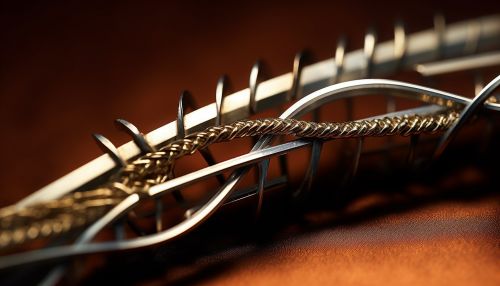Surgical Sutures
History
Surgical sutures, also known as stitches, have a rich history dating back to ancient times. The earliest known use of sutures was by the Egyptians in 3000 BC, as documented in the Edwin Smith Surgical Papyrus. The Greeks and Romans further developed the practice, with physicians like Hippocrates and Galen leaving detailed descriptions of suture materials and techniques.


Types of Sutures
There are two main types of sutures: absorbable and non-absorbable. Absorbable sutures are designed to degrade over time in the body, while non-absorbable sutures must be removed by a healthcare professional.
Absorbable Sutures
Absorbable sutures are typically made from materials that the body can break down over time, such as catgut, polyglycolic acid, and polylactic acid. These sutures are often used in surgeries involving internal organs, as they eliminate the need for suture removal.
Non-Absorbable Sutures
Non-absorbable sutures are made from materials that the body cannot degrade, such as nylon, polyester, and stainless steel. These sutures are typically used for skin closure, as they can be removed once the wound has healed.
Suture Techniques
There are numerous suture techniques used in surgery, each with its own advantages and disadvantages. Some of the most common techniques include the simple interrupted suture, the running suture, and the mattress suture.
Simple Interrupted Suture
The simple interrupted suture is the most basic and commonly used suture technique. It involves passing the suture material through the tissue on one side of the wound, across the wound, and back through the tissue on the other side. Each stitch is tied off individually, allowing for greater precision and control.
Running Suture
The running suture, also known as a continuous suture, involves a single strand of suture material that is run in a continuous line along the wound. This technique is faster than the simple interrupted suture, but it provides less control and is more prone to tension.
Mattress Suture
The mattress suture is a variant of the simple interrupted suture that involves passing the suture material through the tissue on both sides of the wound in a horizontal or vertical pattern. This technique provides greater wound eversion and is often used in areas of high tension.
Complications
While sutures are a critical tool in surgery, they are not without potential complications. These can include infection, scarring, and suture granulomas.
Infection
Infection is a risk with any surgical procedure, and sutures are no exception. Proper wound care and sterile technique can help minimize this risk.
Scarring
Scarring is a natural part of the healing process, but the type and placement of sutures can influence the appearance of scars. Surgeons often use specific suture techniques and materials to minimize scarring, particularly in cosmetic procedures.
Suture Granulomas
Suture granulomas are small, benign growths that can form around sutures. They are typically caused by a reaction to the suture material and can be removed if they cause discomfort or cosmetic concern.
Future Developments
The field of surgical sutures continues to evolve, with ongoing research into new materials and techniques. Some of the most promising developments include barbed sutures, which can provide better wound closure without the need for knots, and drug-eluting sutures, which can deliver medication directly to the wound site.


